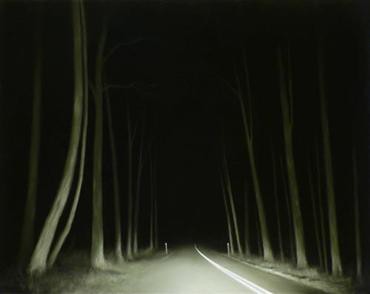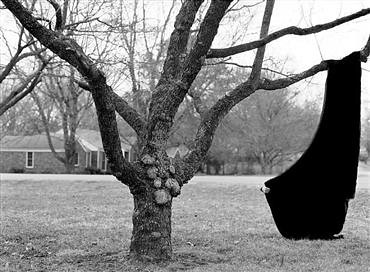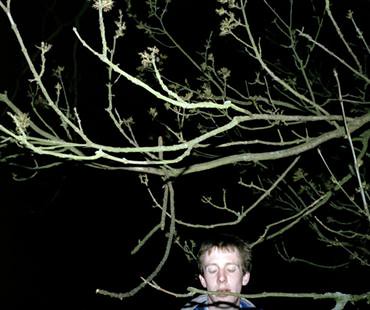How everything turns away
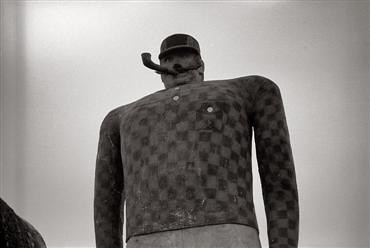 Image: John Vachon Wild Bill Jones - Sam Amidon
Image: John Vachon Wild Bill Jones - Sam Amidon
About suffering they are never wrong, these old mountain songs. Life -- and death -- is what happens while you're mundanely living it. While you're sleeping, tangled careless in bedclothes; or strolling the aisles of a supermarket with your little brown handbasket, scanning the shelves for anchovies and oatmeal; or dancing at a wedding reception, flatfooted and arms flailing, shouting vain requests to a scornful DJ. That's when violence visits some man, unknown to you, with a flash of gunmetal, a flare of light, a scream, a moan. In just a second ... two, three, four. That's when another man discovers he holds a hot revolver in his very own hand -- and has shot a poor boy body and soul.
Other performers of "Wild Bill Jones" have tried to explain the narrator's cruel action, why a seemingly modest, law-abiding citizen shoots on small provocation and becomes an outlaw. In some versions, he is drunk, in others, Wild Bill Jones pulls a knife first. Sam Amidon, in his careful, considered way offers little context and no excuse. His flat-voweled, everyman twang, his da da da da, isn't unkind. But Amidon, like his 19th century predecessors, assumes you know what life is -- brutal, unfair, inexplicable. He assumes you know that while a small human drama plays out, birds carry on building their nests in treetops, a nearby creek's fierce onrush never pauses, a child in a house a half mile away sits down at the kitchen table, lays out her homework and turns on the radio, as she does every school night after dinner. And tonight no different. He assumes you know that a sudden act of violence is just a tiny knot in a sprawling tapestry, an unimportant failure, a murmur drowned out by the bleating, booming, humming, singing, ticking glory of oblivious life bustling all around, beautiful and terrifying, wild and sublime.
With his wonderous plain voice and a small orchestra, Sam Amidon tells nine more stories on All Is Well, which is due for release in February (preorder), Myspace.
Don't want your stories anymore
 Image: Kathy OsbornStormy Weather - Bedroom Walls
Image: Kathy OsbornStormy Weather - Bedroom Walls
"Stormy Weather" was never one of my favorite Pixies songs, and it seems weird that anyone would feel so inspired by the original to want to cover it. Black Francis sang some of his least interesting (and most laconic) lyrics morose and humorless, emphasizing the grim inevitability of discord, the it is time-ness of It is time for stormy weather. The guitars, meanwhile, chugged phlegmatically, like they were stuck jogging on a treadmill. The product of a bitter and contentious period for the band, it isn't much of a stretch to imagine the Bossanova track as a very thinly veiled metaphor for tempestuous internal goings-on.
Los Angeles-based Bedroom Walls, which I expect holds a happier lot of musicians, makes a surprising success of second-rate material. Even from the start -- a flat, queasy warble-wobble of guitar -- it's special. The female vocalist (I've actually only heard Adam Goldberg sing for BW, so I'm not sure who she is) dwells at the deep end of her natural range and enunciates breathy and purse-lipped like a Kim Deal fanclub member in good standing. You get the feeling she's been waiting years to pay tribute and is barely repressing her glee through the performance. The whole band, in fact, sound like a giddy pack of fankids when they burst into the jubilant glockenspiel-gilded chorus. If stormy weather's in the forecast, it's the cheery sort of young-winter white crystalline snowfall with lacey six-sided flakes. This could almost be a Christmas song.
From: Dig for Fire: A Tribute to The Pixies (Amazon, iTunes)
Bedroom Walls' Myspace
Around:
Hey freeloader! Assuage your bittorrenting, mp3-grabbing burdened conscience. New blog, Dear Rockers guilts you into paying back the musicians you've been ripping off, five bucks and one apology letter at a time (with a helpful find-an-address search function).
Kathy Osborn's photos (above) of domestic malice and malaise, as dramatized by plastic dolls, are amazing -- and for sale (if you got the dough).
And if you didn't already see it, I posted an exhaustive -- or perhaps, I mean exhausting -- holiday gift guide. It includes neato stuff for music lovers and lots of artisan-made items. Claim my taste as your own!
In the spirit (gift guide)
 Image: Tokihiro Sako
Image: Tokihiro Sako
Special Rider Blues - Shearwater
This isn't the blues in any conventional sense. Jonathan Meiburg sings as high and desperate as Skip James did. But Shearwater doesn't play the song as rangy and fierce. The band unwinds it slowly, letting the fuzzed wool yarn tangle in their fingers, and only gradually, with languorous laps of guitar, flicks of percussion, do they knit it into something resembling shape. But there it is finally -- a blanket, nubby and warm for you to rub against your cheek. A cover in two senses.
From the rereleased, expanded and gorgeously packaged Palo Santo. Holiday gift alert!
Speaking of gifts... I can't stand shopping crowds, so my holiday goal this year is to buy all of my gifts online. And because I've found so much good stuff in my travels, I figured I'd share some of it. The list got a little long (a lot long) (ok, this is totally insane). Most items are in US $$s. And while there are some expensive goodies, most are less than $25. If you actually take me up on a suggestion and your recipient loves you for it, let me know. This may be the beginning of my new career as a personal shopper.
Music-geekery
Box sets: Stax 50th Anniversary, The Brit Box, Goodbye Babylon early gospel, The Fall's Complete Peel Sessions, People Take Warning: Murder Ballads and Disaster Songs
Gig posters: Aesthetic Apparatus, Programmable Press, Redbird Posters, Dan Stiles
Neko Case Live from Austin and Danielson: A Family Movie DVDs
Raymond Pettibon notecards
Books: The Rest is Noise, Faking It: The Quest for Authenticity in Popular Music, 33 1/3 series, Jay Ryan's 100 Posters, 134 Squirrels
Emotibud earbud set
iPod cases: iPod Crafts, Mod Dots, Hotel Fever and iPod pillow
Daydream Factory t-shirts
Art appreciation
Anemone limited edition artbooklet
View-master reel, Italo Calvino's Invisible Cities
Matte Stephens prints and paintings
Jeff Wall exhibition catalogue
Tiny Showcase Winter prints (Jen Corace, Ryan Jacob Smith, Catia Chien, Evan B. Harris)
Artist's survival kit
Sartorial gestures
Poketo garden t-shirt (women's and men's)
Typewriter t-shirt (men's)
Squirrel hair clip set
Through-the-woods knitted cap
Teal crochet hat
Bags: Antler girl tote, Blue forest market tote, Five penguins tote, Lotta Jandotter tote, Blue swans side zipper, Autumn trees tote, Tree lace tote, Suzi plaid bag
Felted wool coin purse
Krista Raak choker
Paper play
Best American Comics 2007, edited by Chris Ware
Quick Vegetarian Pleasures cookbook
Elephant and Nemo composition book, Sukie Winnebago travel journal, Nantaka Joy "I love" notebook
2008 calendars: Red Prairie Press (Rachel Bone), Hidden Habitats, Mark Rothko, Paper Source letterpress, Smosch mini, Japanese woodblock prints, Valery Goulet, Monster Movies, Seaspray Blue, Charley Harper engagement, Daily planners in fuchsia, lime, orange...
Vintage matchbox labels
Mushroom Hill paper play set
Milkshake bookplates (customized at no extra charge!)
Holiday cards: The Beautiful Project, R. Nichols, Two Guitars, Ink Drop Design birds, Kashimagawa (see above image), V&A 1950s bauble, Koko New York peace
Miscellany
Todd & Holland tea sampler and Bee House 2-cup teapot
CB2 large comma plates in orange, avocado, brown
ZipZip USB memory brick (looks like a Lego!)
Moo-Shu Mitt knitting kit
When I speak of flowers
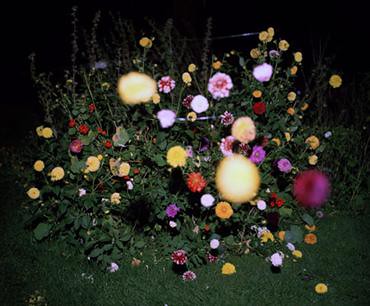 Image: Elspeth DiederixAnnie's Song - Sunshine Club
Image: Elspeth DiederixAnnie's Song - Sunshine Club
I don't apologize for liking John Denver's "Annie's Song." It's sappy and sentimental, but it's a love song, and one of the most naked and risky to ever grace the pop charts. Written upon reconciliation with an estranged wife, it's so vulnerable it's almost embarrassing (almost). It strikes me as a more populist expression of William Carlos Williams' sentiments in the exquisitely moving, "Asphodel, That Greeny Flower," which was also written to a wife at an emotionally fraught juncture. Both gallantly (yet indirectly, and arguably inadequately, through their respective artistic mediums) affirm Williams' agonized assertion, It is ridiculous/what airs we put on/to seem profound/while our hearts/gasp dying/for want of love." "Annie's" rejects airs and profundity for love with every ounce of its hot, quivering heart.
This cover isn't a radical revision. Sunshine Club, a band that existed in 2000 when Denver tribute album Take Me Home (Amazon, eMusic) was released but seems to exist no longer, is content to walk in the songwriter's soft, dusty footprints. Except, where the original is yearning and flushed by the pink glow of optimism, the cover offers a gray whiff of melancholy. It's stark and spare and spacious, seeming to expire less than two minutes in, then only refiring for an instrumental coda. The song is tender, yes, but its wide open spaces leave room for some complications, some uncertainty.
I think I'm going to post a couple more covers this week. Speaking of covers, Berkeley Place is collecting votes for the best covers of the century so far.
Sweet blue world
 Image: Colleen PlumbThe Origin of Rain - Capstan Shafts
Image: Colleen PlumbThe Origin of Rain - Capstan Shafts
Hip to the Sweet Blue World Again - Capstan ShaftsProject of the suspiciously prolific, faux-Brit accented, pretentious song-title bestowing Dean Wells, Capstan Shafts sometimes out-Pollards even Robert Pollard. The 29 tracks on Environ Maiden (CS's seventh full-length following a flurry of self-released LPs) average to less than a minute a pop. And Wells, I'm convinced, built his own recording equipment with tinker toys, scrap metal and bendy straws. In the age of Pro Tools, that there's what's called a conscious choice, a pledge to what can be, in the right hands, the awesome beauty of lo-fi. And by the right hands I mean, of course, someone with a knack for hooks. Oh lordy, the hooks! "The Origin of Rain" is an aching-breaking snip of song whose chord progressions are as lovely and familiar as high school crushes and clam chowder and the smell of snow. The relatively long (49 seconds) "Hip to the Sweet Blue World Again," has a feverish lilt, a buzzing, faintly throttled elation that can't be contained by the walls of the garage where Wells plays a modest Guitar God to the rakes and broken toasters and spare tires. When his voice doubles up on goodbye, I puddle at his feet.
From Environ Maiden (download album from Amazon for only $7.99). Myspace
Little girls
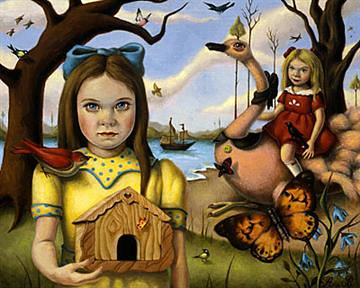 Image: Ana BagayanAlice and Sarah - Orion Rigel DommisseThere's something of Vashti and Joanna and perhaps, Larkin in Orion Rigel Dommisse, this coy-voiced singer named after a winter constellation and one of its brightest stars. And besides sharp, twinkling celestial lights, you can catch snatches of carnival and klezmer, white-tie waltz and Appalachian strum and drang in Dommisse's shadowy sing-song and electric cello orchestra. Her fictions, Alice and Sarah, are made of darker stuff still -- more Angela Carter than Pink Fairy Book. Their white necks smell of nutmeg and cloves, their bare knees blush pink, and yellow satin ribbons flutter like butterflies in their chestnut hair. But this sweet folie à deux would sooner slip razors from the bright folds of their dresses and eviscerate that frog than kiss him.
Image: Ana BagayanAlice and Sarah - Orion Rigel DommisseThere's something of Vashti and Joanna and perhaps, Larkin in Orion Rigel Dommisse, this coy-voiced singer named after a winter constellation and one of its brightest stars. And besides sharp, twinkling celestial lights, you can catch snatches of carnival and klezmer, white-tie waltz and Appalachian strum and drang in Dommisse's shadowy sing-song and electric cello orchestra. Her fictions, Alice and Sarah, are made of darker stuff still -- more Angela Carter than Pink Fairy Book. Their white necks smell of nutmeg and cloves, their bare knees blush pink, and yellow satin ribbons flutter like butterflies in their chestnut hair. But this sweet folie à deux would sooner slip razors from the bright folds of their dresses and eviscerate that frog than kiss him.
From What I Want From You is Sweet (Amazon), Myspace
Haunted
 Image: ghostpatrolUntrue - Burial
Image: ghostpatrolUntrue - Burial
Honey in the Rock - Blind Mamie Forehand
Weight of My Love - David Thomas Broughton
Burial's new album, Untrue (Amazon, eMusic), is a production of relatively few words. The legible ones are channeled via looped vocals of lost club divas, temporally dislocated soul singers and disembodied MCs who shuffle and reshuffle flashcards -- "I envied you," "you lie," "the way I feel inside" -- with a kind of intense randomness. These quotidian phrases scan of text torn from a hundred relationship articles in a dozen different magazines and tossed to the wind (or, of arbitrarily aggregated phrases from a thousand Myspace blogs). Considered with the music's bedemoned beats and underworldly pastiche of synths and reverb, they could be the psychogeographical signposts that signify Bitter Breakup Album. And wouldn't it be boring if Untrue were only that?
Several proponents of sonic hauntology -- a critical model that grafts a key trope of Derrida's critique of Marxism in Spectres of Marx onto considerations of music production modes and receptor response (I know, I know! I'll try to make this as painless as possible) -- have adopted dubstep and Burial as particular pets. (Dub reggae also gets favored status for reasons that will be obvious.) In addition to thoughtful fare, intra-blog potlucks have dished up some woefully undercooked speculations about what might constitute sonic hauntology, including silly lists of songs and artists with the word "ghost" in their name. Ghosts don't, as it seems pretty clear upon consideration, figure prominently in hauntology. Instead, the neologism speaks to something that is neither present nor absent, that collapses the ontological binary (Derrida, in fact, derived his portmanteau in part from "ontology"). Hauntology can explain an erased history that nevertheless leaves recurring spectral traces in the now, or account for how a potholed historical narrative produces, by its absence, meaning in the out-of-time -- or end-of-time -- present.
If you wanted to assert that hauntology sounds like a gussied-up version of the uncanny, or first cousin to various postmodern discourses, I wouldn't argue with you. It does seem to try to grapple with similar fraught and alienating aspects of contemporary life, particularly the decentralized, nonhierarchical ways in which technology disseminates information and we receive it. So yes, hauntology's probably a theoretical fad, or as k-punk puts it more polite, "the closest thing we have to a movement, a zeitgeist." Which doesn't mean it can't be productive of ... something, even something significant. In the latest issue of online journal Perforations, Ian Mathers theorizes the hauntological aspects of Joy Division in provocative ways (though his argument -- which seems predicated on your acknowledgment that Ian Curtis' vocals sounded ghostly before Curtis actually gave up the ghost -- teeters a bit). M Fisher (aka k-punk) performs a more persuasive reading of The Shining (both novel and film), and Sam Miller executes a marvelous Marxist theory-into-practice alchemy about gentrification that I wish was the rule with these types of intellectual exercises, not the exception.
But hell, nobody invests in so fragile a framework as hauntology without a concurrent and significant commitment to its poetic possibilities. This, I'll admit, is why I've been intrigued enough to troll these academese-spiked discussions for a couple months. I first encountered that Perforations issue the same afternoon I found the Valgeir Sigurðsson track I posted on Monday, and on cursory listening/reading, it seemed like serendipity. Hauntology, I thought, corralled "Winter Sleep's" eerie sonics -- specifically, those discordant sputters of noise that irrupt and threaten to rupture the melodic, soft-pattered whole (sort of like the teasing, yet benign threshold violations of poltergeists). But while the tract sounds unsettling and dyschronic, and Sigurðsson's production (he's probably best known for engineering Will Oldham and Björk albums) disinters some hard-to-place sounds, I'm now not convinced that hauntology brings anything interesting to this particular table.
Arguably, all multi-tracked productions -- or even anything mediated by recording technology -- are haunted by the contradiction of presence that isn't; they're performances that never physically happened as you hear them. But recordings that somehow foreground or acknowledge their placeless and timeless status, more willingly lend themselves to hauntological arguments. The hiss and click and pop of a pre-war blues record, for example, isn't contingent, but constitutive of it's meaning. K-punk argues when talking about Robert Johnson, the "'mythologized deep south' arises from the 'layers of fizz, crackle, hiss, white noise.'" So the blanket of fuzz on Blind Mamie Forehand's wonderful gospel-blues side "Honey in the Rock," (found on American Primitive - Volume 2: Pre-War Revenants 1897-1939, Amazon, eMusic) is as critical to the mix as her voice or the guitar. It's intrinsic to our own fabrication of "sincere" and "authentic." (Also, I have to mention that bell's ding ding. It always seems to me like the spectral nagging of repressed memories too terrible to articulate.)
Sonic hauntology can also be a useful way to wrap your head around Burial. Jeez, you could start with the (metal band-ready) name and proceed straight to punny persiflage about sonic resurrection. Or probably better, highlight the artist's shadowy identity (he claims that only a handful of non-family members in his everyday life know of his alter ego). Anonymity, in fact, supplies what could be necessary for a successful hauntological text: stranded and sourceless sound, sound produced by no one. And Burial supports this sense of absent presence by exposing the seams of his production process -- vocodered vocals that could be emanating from (if anywhere physical) a sewer tunnel, and hissy, crackling, patchworked soundscapes. "Untrue," makes me think of a beautiful face that has been disfigured and competently reconstructed by plastic surgery, but whose thin white scars and awkward spatial logic are visible in certain ephemeral light. The album, then, is uneasily beautiful, an elusive work of splendor and risk. And if not as explicitly political as Burial's first record (Amazon, eMusic), political all the same. Take a gander at the track names: "UK," "Homeless," "Dog Shelter," "In McDonald's," uh, "Untrue." Fangirl plots and connects some dots between Burial's aesthetic and an invisible London economy at phantasmal odds with capital's official "commodity urbanism." So yes, and without really getting too deep into it, this record can certainly be read as critique of New Britain.
But I'm not sure even Burial illustrates the possibilities of this theoretical schema quite as well as the case of David Thomas Broughton. Last year, I said this about Broughton's first effort (Amazon, eMusic): "Excessive and often unbordered, the record has inexplicable moments ... and says uncanny things that don't fit in any small boxes I have lying around." What I didn't unpack very well was why and how. The Complete Guide to Insufficiency is a single-take recording in which Broughton uses a sampler to loop back what he's just performed and layer the loops in waves of sonorous din. It's a dizzying, disturbing, emotionally gutting gimmick that conflates past and present and challenges spatial orientation. (And a good account of Broughton's live performance process can be found at The Daily Growl.) Improvisational chamber quartet 7 Hertz supports Broughton's voice and guitar on his latest release (Amazon), so he makes less extensive use of his trusty sampler. But in "Weight of My Love," the vocal sample, it's not the weight I carry with me, ghosts his immediate voice, the sputtering bass, moaning clarinet, keening violins. The delayed and doubled effect is eerie and gorgeous and, above all, metaphysically slippery. It asks us to consider what we're hearing and interrogate our own assumptions about how we construct meaning from the experience.
Elsewhere:
Well hey, whadya know? Carrie Brownstein's NPR blog is a lot of fun.
Twisted round the barren oak













